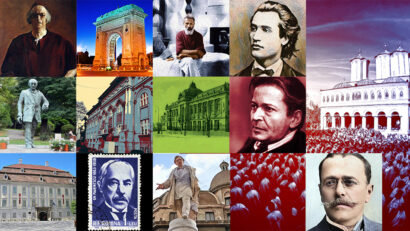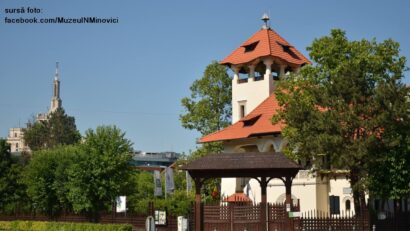Moldavia’s Jewish communities of yore
New book looks at the way of life of Moldavia's Jewish communities going back to the 18th century.

Christine Leșcu, 23.04.2023, 14:00
The
architect Irina Nemţeanu recently published a study entitled
Aspects of habitation of the Jewish community in Moldavia
(1775-1930) in
which she looks at the way of life of Moldavia’s old Jewish
communities.
Her endeavour started from her realisation that the history of
multiculturalism in the Romanian lands had an influence on the local
urban fabric and architecture.
With
respect to the history of Jewish
migration to Moldavia, this
aspect also depended on the social and economic policies pursued by
the different foreign occupations that dominated historical Moldavia:
the Habsburg, Ottoman and Russian empires. The Jews began to settle
her even before 1775, when the migration waves intensified. They
benefited from a certain policy of the Ottoman empire, which had
sovereignty over the principality of Moldavia and thus held a
monopoly on the international sale of many goods that came from
Moldavia. Under the circumstances, the settlement of foreign
merchants in these parts – and who were not subject to the monopoly
imposed on the locals – gave an impetus to
trading
with
areas outside of the empire and made the Moldavian route one of the
most important trading routes in the region.
Irina
Nemțeanu explains in more details how the Jews came to settle in
Moldavia as a result of the regional policy of the big empires:
The
history of these communities in
Moldavia does not begin at the end of the 18th
century, but much earlier. We know there existed older communities in
Siret and Iași
from as early as the 17th
century. What happens at the end of the 18th
century is that the phenomenon was becoming much more visible at an
urban level. A very large number of communities began to migrate to
Moldavia as part of a certain context, which explains many things
that have to do with the areas outside of Moldavia. I’m also
speaking of the fact that the Habsburg Empire took over a number of
territories, including Bukovina, as well as of the area of resistance
in the Russian empire, for example. We should also take into account
the various restrictions faced by the Jewish communities who wanted a
certain amount of freedom of habitation and of practising trade,
freedom they were more likely to find in Moldavia. In certain
respects, the situation here was better than what was happening
elsewhere.
Quite
a few market towns had developed in time in Moldavia, which had been
crossed, as early as the Middle Ages, by a series of important
international commercial routes. The Jews settled in the proximity of
these market towns, even resuscitating some of them which had become
impoverished. Irina Nemțeanu explains:
On
the one hand, I’m referring to Moldavia’s major market towns
which acquired a new role from the beginning of the 19th
century owing to a special political and economic context, places
like Iași, Roman, Dorohoi and other big settlements. On the other
hand, a series of smaller towns began to develop in this changed
economic context and which grew in fact as settlements with a
commercial role near already existing villages and in some cases on
the land of Moldavian boyars. There are many such places: Podu
Iloaiei, Frumușica in Iași county, Ștefănești, Berești. There
are very many examples that in effect demonstrate that this was a
wider phenomenon, although also developing depending on certain
periods and the waves of immigration of these communities, which were
mainly made up of merchants and numbered many Jews.
The
Jewish houses and shops in the area were typical of merchant homes
everywhere: the shop on the ground floor and the residential quarters
either upstairs or at the back. Architect Irina Nemțeanu tells us
more about the characteristics of the Jewish districts in these
market towns:
We
can’t really talk of a Jewish architectural style, but we can say
there were certain common elements throughout the region. A defining
feature is a systematic organisation of certain functions around a
busy commercial route and the intention to hide the ethnic and
religious aspect. This latter aspect also had to do with the host
country, which imposed certain rules for the integration of this
community. On the other hand, at least until the mid 19th
century, the Jewish communities probably tended to hide their places
of worship. This is why the synagogues were most often located
somewhere in the background, not visible, but hidden behind the
houses and the shops. It’s also for this reason, in fact, that
until early 20th
century, owing to this characteristic of the Jewish communities, they
were to be found especially on the outskirts of the city.
Given
this tendency for the Jewish communities to hide the religious aspect
of their way of life, what can be said about the cohabitation of the
Jews with the majority population? Architect Irina Nemțeanu
explains:
There
are two different aspects. On the one hand, these communities lived
in market towns, where habitation would be naturally diffuse, mixed,
so they would have established connections with other allogeneic or
indigenous groups. The settlement was in fact a cultural melting pot.
On the other hand, owing to the fact that these communities were the
most numerous in the market towns, the latter appeared as if they
were almost Jewish settlements. It wasn’t necessarily an intention,
but the result of the settling of people who somehow shared a common
cultural past.
The
appearance of these former market towns is much changed today, with
many of the Jewish houses having disappeared in time. Those that are
still standing are in need of conservation and promotion as part of
the historical and ethnic context in which they first emerged.





























